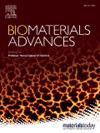Comparative analysis of 3D and 2D cell-culturing methods in hair follicle spheroid morphogenesis and drug responsiveness
IF 6
2区 医学
Q2 MATERIALS SCIENCE, BIOMATERIALS
Materials Science & Engineering C-Materials for Biological Applications
Pub Date : 2025-07-21
DOI:10.1016/j.bioadv.2025.214423
引用次数: 0
Abstract
Three-dimensional (3D) cell-culturing methods have usually been considered superior to two-dimensional (2D) culturing for in-vitro tissue formation intended for tissue engineering and drug research applications, including hair follicle (HF) development. However, cellular interactions within 3D cultures are generally more complex and therefore, may require further investigation. Apart from grafting in-vitro cultured (2D and 3D) dermal papilla cells directly onto the skin of animals to study the impact of 3D culturing on hair inductivity, molecular studies remain lacking in the understanding of how 2D and 3D culturing methods influence the morphogenesis of early stage HF models. The proposition that 3D cultures is always superior to 2D cultures for mimicking HF at its early developmental stage remains unknown. Therefore, this study aimed to investigate the influence of 3D and 2D culturing methods on the morphogenesis of HFs. 3D-cultured spheroids were assumed to exhibit greater expressions of HF-associated proteins and more expected drug-induced expression responses than 2D cultures. Dermal papilla cells and keratinocytes were cultured together in 2D and 3D cultures, where polyethylene glycol diacrylate microwell arrays were designed to provide the 3D culturing environment. Both 2D and 3D cultures were treated with either minoxidil or dihydrotestosterone (DHT) and the expressions of four hair proteins were analyzed.
The results showed that 3D cultures responded in more expected ways than 2D cultures when exposed to minoxidil, demonstrating a significant increase in trichohyalin (AE15, one of the 4 proteins) as expected, while 2D cultures exhibited a significant down-regulation. On the other hand, surprisingly, DHT treatment significantly reduced all protein expressions in 2D culture as expected, but did not significantly alter protein expression in 3D culture, suggesting that 2D cultures could respond better than 3D cultures in DHT treatment.
三维和二维细胞培养方法对毛囊球形形态发生和药物反应性的影响
三维(3D)细胞培养方法通常被认为优于二维(2D)培养,用于组织工程和药物研究应用的体外组织形成,包括毛囊(HF)的开发。然而,三维培养中的细胞相互作用通常更复杂,因此可能需要进一步研究。除了将体外培养的(2D和3D)真皮乳头细胞直接移植到动物皮肤上研究3D培养对毛发诱导能力的影响外,对于2D和3D培养方法如何影响早期HF模型的形态发生,分子研究仍然缺乏了解。3D培养总是优于2D培养在其早期发育阶段模拟HF的命题仍然未知。因此,本研究旨在探讨3D和2D培养方法对HFs形态发生的影响。3d培养的球体被认为比2D培养表现出更多的hf相关蛋白表达和更多预期的药物诱导表达反应。真皮乳头细胞和角质形成细胞在二维和三维培养中一起培养,其中聚乙二醇二丙烯酸酯微孔阵列设计用于提供三维培养环境。用米诺地尔或双氢睾酮(DHT)处理二维和三维培养,分析四种毛发蛋白的表达。结果表明,当暴露于米诺地尔时,3D培养物比2D培养物以更预期的方式做出反应,显示出预期的trichohyalin (AE15, 4种蛋白质之一)的显著增加,而2D培养物表现出显著的下调。另一方面,令人惊讶的是,正如预期的那样,DHT处理显著降低了2D培养中所有蛋白质的表达,但没有显著改变3D培养中的蛋白质表达,这表明在DHT处理下,2D培养比3D培养的反应更好。
本文章由计算机程序翻译,如有差异,请以英文原文为准。
求助全文
约1分钟内获得全文
求助全文
来源期刊
CiteScore
17.80
自引率
0.00%
发文量
501
审稿时长
27 days
期刊介绍:
Biomaterials Advances, previously known as Materials Science and Engineering: C-Materials for Biological Applications (P-ISSN: 0928-4931, E-ISSN: 1873-0191). Includes topics at the interface of the biomedical sciences and materials engineering. These topics include:
• Bioinspired and biomimetic materials for medical applications
• Materials of biological origin for medical applications
• Materials for "active" medical applications
• Self-assembling and self-healing materials for medical applications
• "Smart" (i.e., stimulus-response) materials for medical applications
• Ceramic, metallic, polymeric, and composite materials for medical applications
• Materials for in vivo sensing
• Materials for in vivo imaging
• Materials for delivery of pharmacologic agents and vaccines
• Novel approaches for characterizing and modeling materials for medical applications
Manuscripts on biological topics without a materials science component, or manuscripts on materials science without biological applications, will not be considered for publication in Materials Science and Engineering C. New submissions are first assessed for language, scope and originality (plagiarism check) and can be desk rejected before review if they need English language improvements, are out of scope or present excessive duplication with published sources.
Biomaterials Advances sits within Elsevier''s biomaterials science portfolio alongside Biomaterials, Materials Today Bio and Biomaterials and Biosystems. As part of the broader Materials Today family, Biomaterials Advances offers authors rigorous peer review, rapid decisions, and high visibility. We look forward to receiving your submissions!

 求助内容:
求助内容: 应助结果提醒方式:
应助结果提醒方式:


